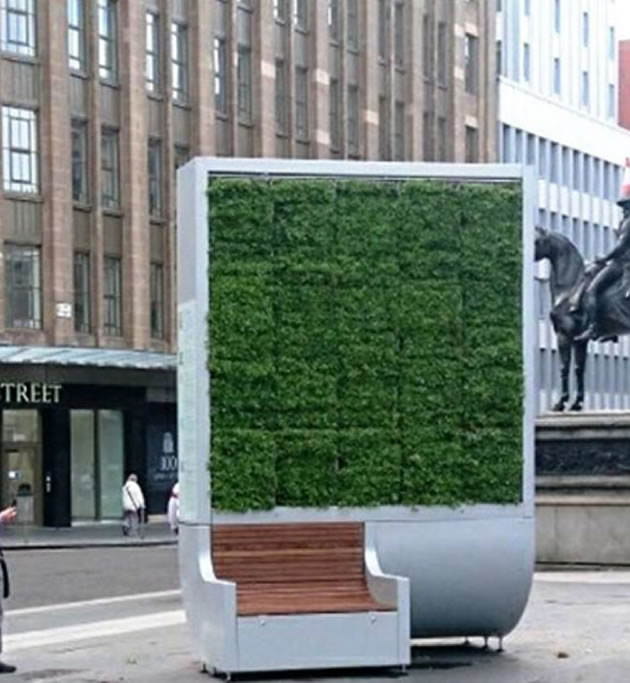Local councillor wants action to protect those near busy roads

A pollution absorbing City Tree in Glasgow
Lccal councillor, John Todd, believes that pre-school nurseries near busy roads in Chiswick should be selected for tests on air pollution levels, both inside and outside their buildings.
20 nurseries overall have been chosen in some of London’s most polluted areas to receive new ‘air quality audits’ as part of Mayor Sadiq Khan's move to clean up toxic air in the capital, following research which shows that indoor pollution in schools can be just as harmful as outdoors.
The audits will target sources of indoor and outdoor pollution, with five of the 20 nurseries trialling new air filtration systems to test their effectiveness at reducing indoor pollution.
They will focus on reducing NO2, PM10 and PM 2.5, as research shows children exposed to these smaller pollution particles and gases are more likely to grow up with lung problems and to develop asthma.
Windham Nursery School, Richmond upon Thames, is the closest to Chiswick, while others chosen are in Camden, Greenwich, Haringey, Kensington and Chelsea, Lambeth, Lewisham and Newham. But Cllr Todd believes that nurseries in Chiswick should be included in the audit, in a similar way to that carried out on three local primary schools.
Cllr Todd said: "We are seeing new research which shows that in some cases the indoor pollution is worse than outside and very young children are most vulnerable. We need to be addressing this urgently in nursery schools in Chiswick considering that three of our local primary schools were found to have some of the highest levels of air pollution in London." He said there were a number of pre school nurseries near the A4, and A315.
The new scheme for selected nursery schools follows 50 audits the Mayor delivered to primary schools earlier this year, including the three in Chiswick, St Mary's RC, William Hogarth Primary and Cavendish Primary- which were selected because of their high levels of pollution due to their location beside busy roads.
Some schools in London are taking action to close roads, upgrade their boilers, tackle engine idling and promote car-sharing schemes.
Parents and staff at St Mary's started a campaign in the wake of the pollution report which has now seen the Chiswick Oasis project reached its funding target ahead of schedule. The achievement now means that a 'green wall' can be installed to reduce air pollution from the A4.
A recent study by University College London and the University of Cambridge,funded by the Mayor, found that indoor air pollution was significantly higher inside classrooms, due to a range of factors including the age of buildings, ventilation, positioning of windows, and wall-to-wall carpeting.
The findings suggested that the protection offered by the building increased the further away it was from the busiest roads and that airtight buildings may offer greater protection against pollution. The report also found that, in most classrooms, annual exposure to small particles was higher than recommended World Health Organization guidelines, and that this was caused by a combination of indoor and outdoor sources.
The audits will also review a range of methods to reduce pollution outside nurseries,including restricting road access outside entrances at drop off and collection times, moving playgrounds away from congested roads, installing green ‘pollution barrier’ hedges, tackling engine idling and promoting cycling and walking.
The £250,000 programme is funded as part of the Mayor’s Air Quality Fund and audits will be conducted by global engineering consultancy WSP, who will spend the next few weeks in the nurseries, assessing indoor and outdoor air pollution sources, looking at how children travel to the nurseries, and reviewing local walking routes including traffic crossings.
A starter grant of £4,500 will be given for the 20 nurseries to help kick-start recommendations on completion of the audits.
Dr Simon Lenton, representative of the Royal College of Paediatrics and Child Health said: "The adverse impact on health of air pollution is now well established in adults. Infants and children are more vulnerable as their lungs and brains are still developing. Children and infants spend many hours in nursery or at school and it is imperative we know what air pollutants they are exposed to and then take action to ensure the air they breathe is as pure as possible. This is particularly important in proximity to high traffic density and close to industrial areas. We fully support the GLA programme in primary schools and nurseries to understand and tackle the problem".
The 20 state funded nurseries were selected, in agreement with the local authority, based on assessments of the current annual average levels of Nitrogen Dioxide near the nursery.
Councillor John Todd has also requested funding to purchase a City Tree, which he says could be of use to a local school near a busy road. The City Tree is 4 metres tall, three metres wide and two metres deep and it is claimed it can remove as much pollution as 275 trees. Each City Tree can remove 240 tonnes of carbon dioxide every year, according to its manufacturer.
They require little maintainance as solar panels power it, and rainwater is collected for irrigation.
Cllr Todd says, "We in Chiswick will continue to look at how innovative and forward-thinking ideas can have an positive impact on the environment. These initiatives will help improve air quality which is good news for all."
He also wants the A4 to be considered part of the Mayor's Ultra Low Emissions Zone (ULEZ).
January 21, 2019